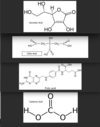Bio-Biochem Flashcards
(264 cards)
How does histone acetylation effect gene transcription?
Histone Acetylation = neutral charge, gene activation, DNA uncoiled.
Histone Deacetylation = positive charge, gene silincing, DNA coiled.
What were the results of the Griffith Experiment? How was Griffith’s conclusion further supported bythe evidence of Avery’s results?
Griffith Experiment: R-form (nonpathogenic) bacteria convered to S-form (pathogenic) by some transforming principle
Avery Experiment: Griffith’s transforming principle = DNA. Evidence… - tested (-) on protein detections but (+) on DNA decection tests - ratio of Nitrogen:Phosphorus resembled that of DNA - protein/RNA degrading enzymes —» no effect
Difference between…
- Facultative anaerobe
- Obligate anaerobe
- Aerobe
- Facultative anaerobe: can function either in presence or abscence of oxygen. (perform aerobic or anaerobic respiration)
- Obligate anaerobe: cannot function in the presence of oxygen
- Aerobe: can only function in presence of oxygen
Bacteria Characteristics (pneumococcus):
1.
2.
3.
Bacteria Characteristics (pneumococcus):
- contains organelles (i.e. ribosome, double membrane bound nucleus structure)
- cells larger in diameter than eukaryotic cell
- translation occurs in mitochondria
Menarche & avg. age of onset
Menarche: beggining of menstruation (ages 9-15+)
Klienfelter’s Syndrome:
- genotype?
- genotypic sex?
Klienfelter’s Syndrome:
- genotype: XXY
- Genotypic Sex: Male—»presence of Y chromosome
-
Characteristics:
- infertile
- female secondary sex characteristics
- Aneuploidy
- Examples?
Aneuploidy: abnormal number of chromosomes -
EX; Monosomy X, Trisomy 21/18/13, XXX/XXY/XYY “
What is an RFLP and what is it used for?
Restriction Fragment Length Polymorphisms (RFLPs): used to identify which parent a non-disjoined chromosome comes from.
Assume that ey is X-linked if ey/+ females are crossed with wt males, what are the phenotypes of the progeny?
- (Y) = Y chromosome
- (ey) = small or no eyes (depending on sex & genotype_
- (+) = Normal eyes
Male:
A. (Y/+) —» NORMAL
B. (Y/ey) —» no eyes
Female:
A. (ey/+) —» small eyes
B. (+/+) —» NORMAL
Constitutive vs. Substitution Mutations
Constitutive: ““always active”” mutation—»increase ‘strength’ of binding for weak GAL4 promotor thereby inc. transcription
Substitution: mutation to unstream activiating sequence (UAS) would only dec. efficiency of GAL4 promoter
Hardy-Weinberg Equation
p^2+2pq+q^2=1
p: frequency of wt allele
q: frequency of recessive allele
Is it more practical to compare the entire genome of a wt vs. cancerous cell in order to isolate a mutation? what is a better alternative?
naturally occuring mutations would mask cancer-causing mutations, making it an impractical method for attempting to isolate a mutation.
better alternative = transforming human (hDNA) sequence that upregulates replication & a tag sequence into e. coli then adding this DNA to a mouse cell line.
what are the 3 types of sequencing transfers and what molecules are they used to detect?
Southern Transfer: detection of DNA sequence in DNA samples
- combines transfer of electrophoresis-separated DNA fragments to a filter membrane and subsequent fragment detection by probe hybridization
Northern Transfer: detection of RNA fragments
Western Transfer: detection of proteins”
what codon & AA does the initiator tRNA aminoacyl bind to?
initiator aminoacyl tRNA binds the start codon and transports the AA formylmethionine
Polysomes (Polycistronic mRNA):
- cell type?
- protein translation?
- polycistronic mRNA found in prokaryotic cells.
- contain multiple start codons and proteins are translated separately into many proteins
what organelles are found within a prokaryote?
ribosomes, nucleoid, plasmid, cytoplasm, flagella/pilli, cell wall, and plasma membrane
a non-membrane bound form of CD14 stimulates endothelial cells via interactions w/LPS.
Would CD14 be found in the blood/ECF or the cytoplasm of the endothelial cell?
CD14 would be found within the blood/ECF b/c LPS is released by bacteria in the ECF, therefor CD14 could only interact if its also in ECF.
How does the nuclear envelope confine translation to the cytosol?
Nuclear Envelope: inner (chromosomal DNA & nuclear RNA) & outer (studded w/ribosomes) membrane system
– perforated by nuclear pores (aqueous channel) that are too small for ribosomes (~30nm) to pass through
– pores are capable of expansion if a molecule contains a nuclear import signal
What is the diameter of a nuclear pore, and how does it accomodate the passage of molecules that exceed the size of the pore?
- nuclear pore = ~9nm diameter
- presence of nuclear import signal (containing (+) AA’s) allows nuclear pore to expand to accomodate objects > 9nm
If RNA is injected into a nucleus and later found in the cytosol, and then injected into the cytosol of a 2nd cell, and no RNA was found in the nucleus, where is the receptor most likely located?
nuclear export signal would be found on the nucleoplasmic face
What’s the difference between Gram-positive and gram-negative bacteria?
- *Gram (+):**
- thick peptidoglycan layer
- no LPS
- *Gram (-):**
- Ex: e. coli
- express LPS—»stimulate inflammatory immune response
- thin peptidoglycan layer (network forms double membrane w/periplasmic space)
a phosphatidylethanolamine molecule is formed from which components?

what is the greatest contributing fator as to why integral membrane proteins do not diffuse transversley accross a membrane?
Asymmetric Distribution of Proteins—» integral proteins vary at ECF vs. cytoplasm & hydrophillic regions cannot transverse hydrophobic interior of PM
How many moles of water are required to hydrolyze a peptide bond?






















